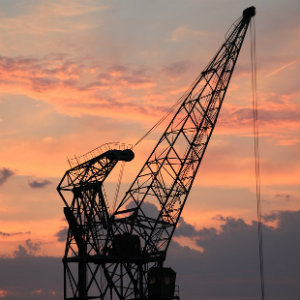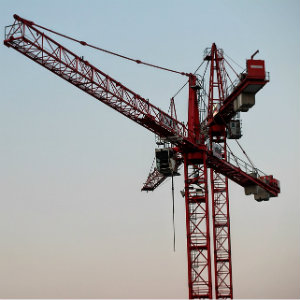Were you or a loved one injured by a construction crane? You probably have a number of concerns:
- I was injured as a pedestrian. Who is responsible?
- Who is liable if I was injured on the job?
- How will I support myself after losing my spouse?
- What are my legal options?
We have experience helping injured workers, their families, and civilian victims of crane accidents.

Our attorneys are here to help guide you following a preventable crane accident.
Like all forms of heavy machinery, cranes help to make construction projects easier. However, their powerful nature comes with a price. When mistakes are made, workers may suffer from a variety of serious injuries, and some may even die as a result. Cranes are most often used for building projects in urban areas, so civilians outside of the construction site could also be injured. Most of these accidents could have been avoided if proper safety measures had been followed.
Cranes are often involved in struck-by accidents when a worker is struck by a moving or falling object. These account for 9.6% of construction worker fatalities. The force of such a heavy piece of machinery is extremely deadly.
Who Is Liable In A Crane Accident?
Crane accidents don't just materialize out of thin air. They almost always could have been avoided if it weren't for a negligent party. Investigations can usually pinpoint the cause of the accident. Possible at-fault parties include:
- Crane operators - Many accidents result from operator errors. In 2013, a crane collapsed into a Salvation Army store in downtown Philadelphia. The investigation determined that the operator was under the influence of codeine and Percocet at the time of the accident. Six people died and fourteen were injured as a result of his reckless behavior.
- Employers - Construction site managers are obligated to provide proper training for crane operations. If a crane accident results from inadequate training, then an employer may be found negligent for the accident.
- Manufacturers - Occasionally, an accident may be caused by poorly built equipment. If an equipment malfunction caused the accident, then the crane manufacturer may be determined liable.
FREE CONSULTATION
Common Types Of Accidents
Improper crane operation can result in a few different types of accidents.
Falling Objects & Debris
Cranes lift heavy objects and carry transport them to other parts of the construction site. It's extremely important that a crane is safely maintained and operated. Being struck by a falling object from such a high distance can cause devastating injuries or death.
In Manhattan in 2015, an industrial air conditioner plummeted 30 stories into the heart of midtown after a crane cable snapped. Two construction workers and eight civilians were injured by falling debris in the accident. Fortunately, this occurred on a Saturday morning. The casualties may have been much worse at a busier time. "Thank God this incident occurred at an hour of the day on a weekend when there weren't too many people around," NYC Mayor Bill de Blasio said after the accident.
Electrocution
Cranes operate high above the ground, often at eye-level with skyscrapers. Occasionally, the operator will accidentally steer the crane into power lines. This may result in the electrocution of the operator or other workers in the immediate vicinity of the crane. In October of 2016, two Atlanta-area construction workers were working at the base of a crane when it struck some power lines. They were both severely shocked and had to be aninirlifted to the hospital with life-threateg burns.
Collapse
Occasionally, the entire crane will collapse or tip over, crashing into the ground below. These are some of the scariest construction accidents. Cranes are massive, heavy objects and the impact area of a collapse can span multiple city blocks. In February of 2016, a crane collapsed in Lower Manhattan, spanning two full blocks in TriBeCa. Three people were injured and one died as a result. All of these victims were civilians outside of the construction site.
An investigation into this collapse revealed that it was caused by an operator error. The Department of Labor also chastised the crane company for "not having any procedure or policy...regarding wind, ice, and snow." Investigators initially thought high winds were to blame for the accident. However, the facts show that this tragedy could have easily been avoided if the company had a more thorough protocol and training program for crane operation.
Preventing Crane Accidents
As we can see from the examples above, crane mishaps often have disastrous consequences. It is crucial that construction employers stress the importance of safety standards, especially when  operating such heavy machinery. These companies too often cut corners in order to maximize profit while neglecting proper safety. Injured workers and bystanders suffer the consequences.
operating such heavy machinery. These companies too often cut corners in order to maximize profit while neglecting proper safety. Injured workers and bystanders suffer the consequences.
Developing a specific safety plan is the best way to prevent crane accidents. Crane rental company All has developed a five-point plan to follow:
- Assess - Assess the construction site for any potential hazards which could induce an accident, and make sure the site is properly prepared for lifting operations.
- Establish - Establish a safety plan for each lift. Assign responsibility to team members to make sure the plan is followed. Make sure the crane has the right capacity for the job, and that all equipment has been thoroughly maintained and inspected prior to each use.
- Assign - Assign a competent person to oversee crane operations. Grant them the authority to stop the operation if he or she witnesses any possible dangers. OSHA defines a competent person as "one who is capable of identifying existing and predictable hazards in the surroundings or working conditions which are unsanitary, hazardous, or dangerous to employees, and who has authorization to take prompt corrective measures to eliminate them."
- Utilize - Utilize qualified operators, signalpersons, and riggers. The crane operator needs to be capable of running the crane, handling load charts, pre-inspections, and set-ups. The load must be properly rigged by a competent rigger. A signaling method should be established (such as hand or radio signals), and a competent signalperson should be assigned this responsibility.
- Train - Anyone who is working in the vicinity of a crane should be trained in lifting operations. Those involved in maintenance, repairs, and assembly should receive thorough training in these tasks.
Relevant Construction Pages
Monheit Law Montgomery County Office 215-866-2018
Directions to our Montgomery County Injury Law Office
4V4Q+FM Jenkintown, Pennsylvania
Open 24 hours
Crane accident attorney Jenkintown
Civil law attorney
Employment attorney
Law firm
Attorney
Social security attorney
Monheit Law South Philly Office 215-302-0095
Directions to our South Philly Injury Law Office
WRCH+CP Philadelphia, Pennsylvania
Open 24 hours
Crane accident attorney South Philly
Civil law attorney
Employment attorney
Law firm
Attorney
Social security attorney
